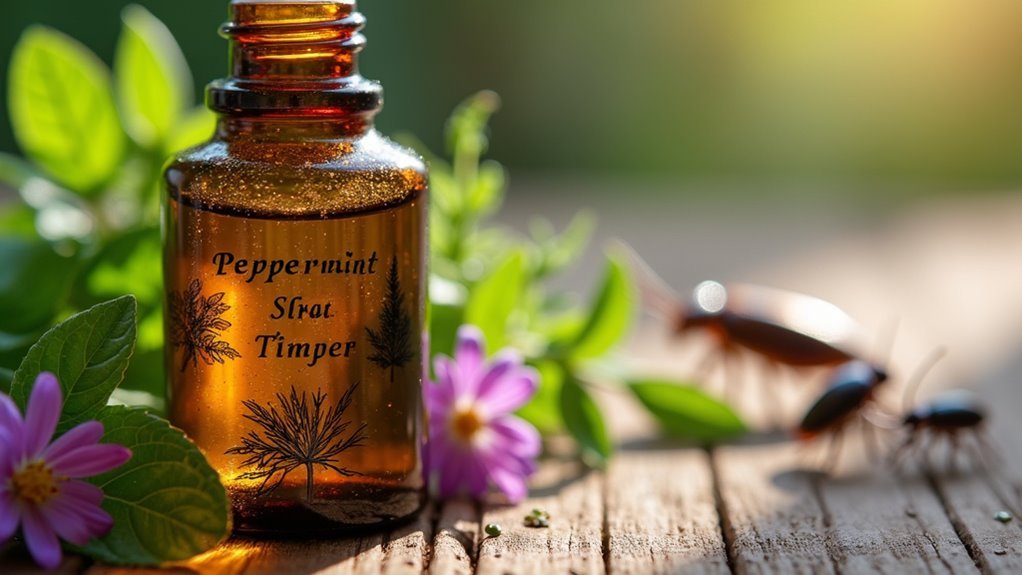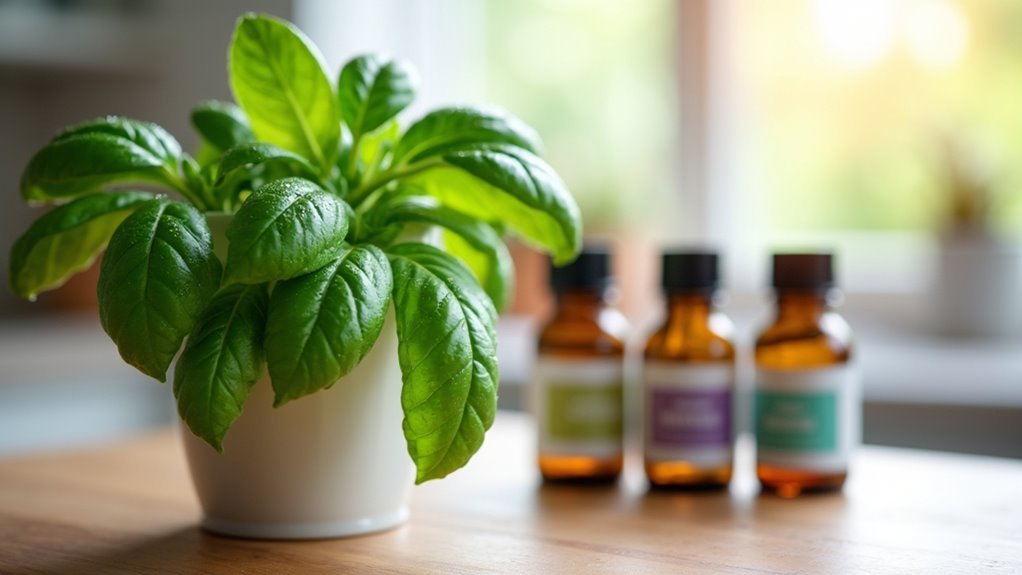You can effectively repel cockroaches using essential oils like peppermint, tea tree, and rosemary, which disrupt their navigation and achieve high mortality rates. Diatomaceous earth damages their exoskeletons and causes fatal dehydration, while catnip’s nepetalactone compound overwhelms their senses. Baking soda mixed with sugar or onions eliminates roaches naturally, and maintaining strict cleanliness removes their food and water sources. These organic methods work best for prevention and minor infestations, though understanding proper application techniques will maximize your success against these persistent pests.
Essential Oils That Effectively Repel Cockroaches

When you’re dealing with a cockroach problem, essential oils offer a powerful yet natural solution that targets these pests’ sensitive olfactory systems. Peppermint, tea tree, and eucalyptus oils create strong scents that overwhelm cockroaches’ ability to navigate, making them excellent choices to repel cockroaches from infested areas.
Rosemary oil stands out as particularly effective, achieving up to 100% mortality rates at concentrations between 2.5% to 30%, functioning as both a cockroach repellent and natural insecticide.
Rosemary oil delivers exceptional results with 100% mortality rates, making it a dual-purpose natural cockroach repellent and insecticide.
Citronella oil works well when soaked into cotton balls and strategically placed, while cedarwood oil disrupts their pheromone communication.
You’ll find that combining oils like clove and thyme enhances effectiveness by targeting multiple aspects of cockroach behavior simultaneously.
Diatomaceous Earth as a Natural Cockroach Deterrent
Beyond essential oils, diatomaceous earth offers another potent organic weapon in your fight against cockroaches. This natural cockroach deterrent consists of fossilized diatom remains that damage roach exoskeletons upon contact, causing fatal dehydration.
Unlike chemical alternatives, diatomaceous earth provides effective natural pest control that’s completely safe for pets and humans.
You’ll need to clean and seal food sources before application, forcing cockroaches to encounter the powder. Apply DE in areas where roaches frequently travel, ensuring the powder stays dry for maximum effectiveness.
This organic pest control solution remains active indefinitely when undisturbed. Regular monitoring and reapplication will steadily reduce cockroach populations over time, making diatomaceous earth an excellent long-term strategy for maintaining a roach-free home naturally.
Using Bay Leaves to Keep Roaches Away

You can scatter crushed bay leaves around kitchen cabinets, pantries, and other areas where cockroaches frequently appear.
The aromatic oils in bay leaves may create an unpleasant environment for roaches, though you shouldn’t expect dramatic results.
While this natural method offers a chemical-free approach, it’s important to understand that bay leaves have significant limitations and won’t eliminate serious infestations.
Bay Leaf Placement Strategy
Where can you find an accessible, aromatic solution hiding in your spice cabinet? Bay leaves offer a natural repellent approach that transforms cockroaches’ behavior through strategic placement.
These common herbs create an unpleasant environment that deters roaches from infested areas.
Maximize your bay leaf effectiveness with targeted positioning:
- Kitchen cabinets – Crush leaves and sprinkle inside cabinet corners where roaches hide
- Pantry shelves – Place whole or crushed bay leaves near food storage areas
- Behind appliances – Scatter crushed leaves where cockroaches commonly travel
- Entry points – Position bay leaves near cracks and crevices roaches use
Remember to refresh your bay leaves regularly for sustained repellent properties.
While effective, combine this method with other pest control methods for thorough roach management rather than relying solely on this natural solution.
Effectiveness and Limitations
Although bay leaves remain a popular natural remedy, their actual effectiveness against cockroaches tells a different story. Scientific evidence shows these natural cockroach repellents don’t markedly impact roach behavior, despite widespread belief in their power.
| Aspect | Reality | Limitation |
|---|---|---|
| Effectiveness | Minimal deterrent effect | Cockroaches aren’t markedly affected |
| Results | Highly variable outcomes | Can’t rely on consistent performance |
| Infestations | May cause relocation only | Won’t eliminate established populations |
| Success Stories | Anecdotal success reported | No scientific backing |
| Usage | Not suitable as primary method | Should supplement other strategies |
While you might experience some success with bay leaves, their limitations make them unreliable for controlling cockroach populations. You’ll need more robust solutions for serious infestations.
How Catnip Works Against Cockroach Infestations
When you’re searching for a natural way to combat cockroach infestations, catnip emerges as one of the most effective organic solutions available. This herb contains nepetalactone, a powerful compound that disrupts cockroaches’ sensory perception, making it an excellent natural repel method for pest control.
Here’s how catnip works against cockroaches:
- Sensory disruption – Nepetalactone interferes with cockroaches’ ability to navigate and process environmental cues.
- Scent deterrent – The herb’s aroma is naturally unpleasant to cockroaches, causing avoidance behavior.
- Safe application – You can place catnip satchels in problem areas without worrying about toxicity to pets or humans.
- Long-term effectiveness – Regular renewal maintains this non-toxic pest control solution’s potency.
This makes catnip an ideal choice for residential cockroach management.
Borax and Sugar: a Deadly Organic Combination

Two simple household ingredients create one of nature’s most effective cockroach elimination strategies.
You’ll find borax and sugar remarkably powerful for cockroach control when combined in a three-to-one ratio. This natural solutions approach works because sugar attracts roaches while borax disrupts their digestive systems upon consumption.
You can sprinkle this mixture wherever you’ve spotted roach activity. The effectiveness extends beyond killing individual insects – roaches carry borax back to their nests, reducing entire populations.
Strategic placement of this borax-sugar mixture creates a chain reaction that eliminates entire roach colonies, not just individual pests.
This method proves more cost-effective than commercial pest control products since both ingredients are inexpensive and readily available.
While borax offers safe home use when applied correctly, you must keep it away from children and pets.
This deadly combination represents true organic repelling roaches success.
Neem Oil’s Role in Cockroach Control
You’ll find neem oil stands out as one of nature’s most potent cockroach deterrents, thanks to its active compound azadirachtin that disrupts insect hormones.
When you apply this biodegradable solution correctly, it can dramatically reduce cockroach populations while keeping your family and pets safe from harsh chemicals.
However, you should understand both its proper application methods and realistic limitations before relying on neem oil as your primary pest control strategy.
Neem Oil Properties
The neem oil extracted from the neem tree serves as a powerful organic weapon against cockroaches due to its unique chemical composition. This natural insecticide contains azadirachtin, which disrupts cockroaches’ hormonal systems and reproductive cycles.
When you’re seeking effective pest control solutions, neem oil offers these key properties:
- Hormonal disruption – Azadirachtin interferes with cockroach growth and development.
- Dual-action formula – Works as both a repellent and lethal agent upon ingestion.
- Safe application – Non-toxic to humans and pets when used properly.
- Water-soluble effectiveness – Easily mixed into spray solutions for targeted application.
You’ll find that regular neem oil treatments can repel cockroaches while gradually eliminating existing populations.
This organic approach provides long-term pest management without exposing your family to harsh chemicals.
Application Methods Explained
Understanding neem oil’s powerful properties sets the foundation for successful cockroach control, but proper application determines your results.
You’ll need to mix neem oil with water in a spray bottle at a 1:5 ratio—one part neem oil to five parts water. Apply this solution directly to areas where cockroaches are active, including cracks, crevices, and entry points.
Regular application creates a protective barrier that’s effective at deterring roaches from returning to treated areas. Since neem oil is safe for indoor use around pets and humans, you can apply it confidently throughout your home.
For enhanced results, combine neem oil with other natural repellents like essential oils to maximize your cockroach control efforts.
Effectiveness and Limitations
While neem oil offers impressive cockroach-repelling capabilities, it’s important to understand both its strengths and limitations before relying on it as your primary defense.
This organic solution disrupts cockroaches’ hormonal balance through azadirachtin, inhibiting their feeding and reproduction. However, you’ll need realistic expectations about what neem oil can accomplish in your pest control strategy.
Key effectiveness factors:
- Concentration matters – Higher concentrations deliver better results when you’re trying to repel cockroaches.
- Contact required – Cockroaches must encounter treated surfaces for maximum impact.
- Variable results – Effectiveness depends on infestation severity and application consistency.
- Best as supplement – Works most effectively when combined with proper sanitation and other pest control methods.
Understanding these limitations helps you use neem oil strategically rather than expecting it to single-handedly solve severe infestations.
Plants That Naturally Deter Cockroaches
Before reaching for chemical sprays, consider harnessing nature’s own pest control arsenal by growing specific plants that cockroaches naturally avoid. These natural deterrents offer effective, non-toxic solutions for your home.
Rosemary and catnip stand out as powerful repel options, with catnip’s nepetalactone compound proving particularly effective against cockroaches. Mint varieties, including spearmint and peppermint, overwhelm cockroach olfactory senses with their potent aromas. You can use these plants fresh or convert them into essential oils for broader application.
Chrysanthemum flowers contain pyrethrins—natural insecticides that both repel and kill cockroaches on contact. Lavender provides dual benefits, offering pleasant fragrance while deterring pests.
While cucumber plants show some promise, they’re less reliable than these proven alternatives for consistent cockroach control.
Baking Soda Methods for Roach Elimination
After exploring plant-based deterrents, you can tackle cockroach infestations with one of the most accessible household items: baking soda. This non-toxic solution offers effective elimination methods that keep your family and pets safe during pest control efforts.
Here are four proven baking soda techniques:
- Onion mixture – Combine baking soda with diced onions to attract roaches while disrupting their digestive systems.
- Sugar bait – Mix baking soda with sugar to lure cockroaches before eliminating them upon ingestion.
- Direct application – Sprinkle pure baking soda in high-traffic roach areas, keeping it dry for maximum effectiveness.
- Consistent treatment – Apply regularly alongside proper cleanliness practices to considerably reduce populations over time.
These methods provide safe, organic alternatives to chemical pesticides.
Citrus-Based Organic Repellents
You can harness citrus’s natural repelling power through two effective methods that cockroaches absolutely hate.
Creating citrus oil sprays lets you target specific areas where roaches enter or hide, while strategically placing fresh peels creates barrier zones they won’t cross.
Both techniques exploit cockroaches’ sensitive smell receptors, making your home an unwelcome environment for these persistent pests.
Citrus Oil Spray Methods
Several citrus oils offer powerful natural solutions for repelling cockroaches from your home.
These natural repellents work by disrupting roach navigation through their strong scent, while limonene compounds prove toxic to cockroaches when concentrated.
Creating an effective DIY citrus oil spray requires these simple steps:
- Mix 10-15 drops of citrus essential oils (lemon or orange) with 2 cups water in a spray bottle
- Shake thoroughly before each application to guarantee proper oil distribution
- Spray around entry points, baseboards, and areas with visible cockroach activity
- Reapply every 2-3 days for maximum effectiveness
You’ll enhance results by combining citrus oils with other essential oils like peppermint or eucalyptus.
Regular cleaning with citrus-scented products also masks food odors that attract roaches, creating a thorough repelling strategy.
Fresh Peel Placement Techniques
Fresh citrus peels create an immediate and cost-effective cockroach deterrent that complements your spray applications perfectly. You’ll want to place these natural repellents in strategic locations where roaches commonly travel and hide.
| Location | Peel Type | Replacement Schedule |
|---|---|---|
| Kitchen cabinets | Lemon/Orange | Every 3-4 days |
| Under sinks | Lemon | Every 2-3 days |
| Near trash cans | Orange/Lime | Daily |
| Pantry shelves | Lemon | Every 4-5 days |
| Behind appliances | Orange | Every 3 days |
To enhance effectiveness, combine fresh citrus peels with bay leaves or essential oils. The strong oils overwhelm cockroaches’ senses, forcing them to avoid treated areas. You must maintain potency by replacing peels regularly, as their scent diminishes quickly. This consistent approach helps deter roaches naturally without harmful chemicals.
Soap and Water Solutions for Cockroach Control
When you’re dealing with visible cockroaches and need an immediate solution, soap and water offers one of the simplest yet effective organic methods available. This approach works by suffocating cockroaches when the soap clogs their breathing pores upon direct contact.
To implement this control method effectively:
For maximum effectiveness, apply the soap-water mixture directly onto cockroaches using a spray bottle with equal parts of each ingredient.
- Mix equal parts liquid soap and water in a spray bottle for targeted application.
- Spray directly onto visible roaches for immediate elimination through suffocation.
- Use as a quick fix only since it won’t address hidden populations in infestations.
- Combine with regular cleaning and maintenance to reduce environmental attractiveness to cockroaches.
While this solution provides instant results against roaches you can see, it’s not an all-encompassing approach for eliminating entire infestations since cockroaches often hide in inaccessible areas.
Spice-Based Deterrents Using Kitchen Staples
While soap and water handles visible cockroaches on contact, you can create longer-lasting deterrent barriers using common spices already sitting in your kitchen cabinets.
These spice-based deterrents work by overwhelming cockroach senses with potent aromas they can’t tolerate.
Mix cayenne pepper, garlic powder, and onion powder to create an effective repelling cockroaches blend. Cayenne’s capsaicin acts as an irritant, while garlic powder and onion powder release intense aromas that drive roaches away.
Sprinkle this mixture liberally around cockroach-prone areas like baseboards, cabinet corners, and entry points.
You can also use cinnamon and black pepper individually for their strong smell properties.
The key to maintaining effectiveness is regularly renewing these natural deterrents, reapplying them weekly or after cleaning to guarantee continuous protection against unwanted pests.
Maintaining Cleanliness as an Organic Defense Strategy
Beyond spice deterrents, your most powerful organic defense against cockroaches lies in maintaining a consistently clean environment that eliminates their basic survival needs.
These organic solutions focus on removing what attracts roaches rather than using chemicals.
Organic roach control eliminates attractants naturally instead of relying on harsh chemical treatments that may harm your household.
Here’s how maintaining cleanliness creates effective natural barriers:
- Eliminate food sources – Clean dirty dishes immediately and wipe down surfaces to remove crumbs that attract cockroaches.
- Seal food properly – Store all food items in airtight containers to prevent access.
- Control water access – Fix leaks and eliminate standing water since roaches can’t survive without moisture.
- Practice decluttering – Remove clutter and organize spaces to eliminate dark hiding spots roaches prefer.
Consistent cleaning practices like regular vacuuming considerably reduce infestation chances naturally.
When Organic Methods Work Best Vs Professional Treatment
Organic methods prove most effective when you’re dealing with occasional roaches or want to prevent future infestations, but they’ve clear limitations that determine when professional intervention becomes necessary.
Essential oils and natural deterrents like diatomaceous earth work well for minor problems when combined with consistent cleanliness. You’ll find these organic methods excellent for ongoing pest management and creating hostile environments that discourage roach activity.
However, they lack the immediate impact needed for severe infestations.
Professional treatment becomes essential when you’re facing widespread or persistent problems. Exterminators use stronger, targeted products and thorough strategies that address root causes beyond surface solutions.
While organic methods provide valuable long-term prevention, they simply can’t match the speed and effectiveness of professional-grade treatments for serious infestations.
Frequently Asked Questions
What Is the Best Natural Repellent for Roaches?
You’ll find essential oils like peppermint, tea tree, and eucalyptus work best as natural roach repellents. Mix them with water and spray around entry points while maintaining cleanliness to enhance their effectiveness.
What Smell Keeps Roaches Away Naturally?
You’ll find strong scents like peppermint, eucalyptus, and tea tree oils effectively repel roaches naturally. Citrus peels, garlic, cayenne pepper, catnip, and rosemary also work well due to their overwhelming aromas that cockroaches can’t tolerate.
What Makes Roaches Go Away Naturally?
You’ll eliminate roaches naturally by combining essential oil sprays, borax-sugar baits, and diatomaceous earth applications. Keep surfaces clean, seal food containers, and scatter catnip or bay leaves to disrupt their pheromones and force relocation.
What Is the Cockroaches Natural Enemy?
You’ll find cockroaches’ natural enemies include geckos, centipedes, spiders, and insect-eating birds. Parasitic wasps lay eggs inside roaches, while ants attack weakened ones. Entomopathogenic fungi also infect and kill them naturally.
In Summary
You’ll find that organic cockroach solutions can effectively reduce infestations when you’re consistent and patient. Essential oils, diatomaceous earth, and kitchen spices work best as preventive measures rather than quick fixes. You should combine multiple methods and maintain strict cleanliness for best results. However, don’t hesitate to call professionals if you’re dealing with severe infestations, as organic solutions won’t always eliminate large populations completely.





Leave a Reply